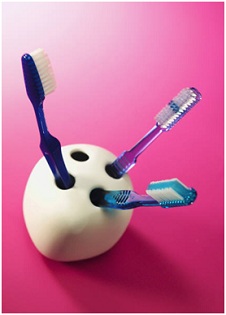 Your little bathroom friend, the toothbrush, is your major ally in preserving good oral health, preventing tooth decay, gum disease and all sorts of other complications. So, it’s time for you to “brush up” on your toothbrush knowledge.
Your little bathroom friend, the toothbrush, is your major ally in preserving good oral health, preventing tooth decay, gum disease and all sorts of other complications. So, it’s time for you to “brush up” on your toothbrush knowledge.
Your toothbrush has a limited life span. You may love your toothbrush, but it is not a “forever” relationship. Most dentists urge you to change toothbrushes every three months in order to avoid brushing your teeth with bacteria and germ-laden brushes. In addition, if you have come down with a cold or flu, it is a good idea to purchase a new toothbrush. If you are a frequent traveler and you keep an extra toothbrush in your cosmetics bag, be mindful of the life of that toothbrush and consider repurchasing a new travel toothbrush, too. Obviously, a toothbrush that shows its age via discolored or bent bristles needs to go!
Some toothbrushes are better than others. Know the difference between hollow-head toothbrushes and solid-head toothbrushes. Hollow-head toothbrushes allow 3,000 times more bacterial growth. In addition, soft bristles are generally better and provide a more gentle cleanse. A smaller toothbrush head allows you to reach more areas of your mouth. Any handle, by the way, that feels good in your hand and that encourages you to brush, is a good handle.
Toothbrush down time: Your toothbrush needs to be able to dry. So, please be sure that your toothbrush is stored vertically with the brush at the top. Any toothbrush that stays perpetually wet is a germ factory waiting to happen.
You need to spend some quality time with your toothbrush. Ideally, you should brush your teeth for two minutes each time. You can use your stopwatch function on your smart phone to help you learn how long two minutes is. This is enough time for you to gently brush the chewing surfaces of all of your teeth, the gumline area, the areas between teeth and even your tongue, if you work efficiently.